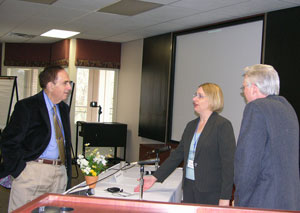 |
From left: UNMC Chancellor Harold M. Maurer, M.D., discusses clinical and translational research with University of Minnesota professor Elizabeth Seaquist, M.D., and Lynell Klassen, M.D., professor and chairman of the UNMC Department of Internal Medicine, at Thursday’s strategic planning retreat. |
That was the word Thursday from two experts on the respective subjects who served as visiting faculty during the Chancellor’s Strategic Planning Retreat at the Westside Community Conference Center in Omaha.
During a panel discussion on teaching health care quality, Leslie Hall, M.D., professor at the University of Missouri, described how Missouri has implemented a health care quality education program.
Missouri found teaching health care quality – which is the idea of providing the best possible overall care for each patient — worked best by having groups of students from multiple disciplines collaborate in realistic situations.
“The students were receptive and very good at finding faults and recognizing issues that hinder patient care,” Dr. Hall said, noting that students seemed to perform better in the multidisciplinary groups rather than in more traditional teaching settings such as lectures.
UNMC’s Sheila Ryan, Ph.D., and The Nebraska Medical Center’s Steve Smith, M.D., discussed the steps that are currently being taken at the medical center in terms of teaching health care quality.
|
|
Both Drs. Smith and Ryan agreed that UNMC needs to do more across the board in terms of teaching health care quality.
“I think the data is pretty clear that this is an important issue,” Dr. Smith said. “Making this a priority is what we need to work on today. I know we can assemble a great team of experts to help a patient but we need to make sure that this great team works well together.”
Dr. Ryan agreed with Dr. Hall’s finding that hands-on training of students — and even current health care professionals — from across disciplines is likely the best way to teach health care quality.
“There isn’t a care problem that can be resolved with one person, one discipline, one unit,” Dr. Ryan said. “Having different professions learning together is more than knowing what they do. It is using each other’s strengths to improve patient results.”
The idea of crossing disciplines arose again during the retreat’s second panel discussion, which focused on clinical and translational research.
Elizabeth Seaquist, M.D., professor of medicine at the University of Minnesota and director of that university’s General Clinical Research Center (GCRC), said the advent of the National Institutes of Health’s (NIH) Clinical and Translational Science Awards (CTSA) will force researchers from differing disciplines to become more collaborative in order to compete for federal funding.
CTSAs will only be awarded to 60 medical centers nationwide. They are meant to create a more center-based system for funding clinical research, which officials feel will increase cooperation among disciplines and make the translation of research from bench to bedside to community more efficient, Dr. Seaquist said.
“CTSAs are designed to lower barriers between disciplines, break down the silos, break barriers and break convention,” Dr Seaquist said. “We have to transform what we’re doing and that involves really thinking about things differently.”
|
|
UNMC wants to qualify for CTSAs and many resources are in place that make getting such funding possible, said Jennifer Larsen, M.D., associate dean for clinical research in the College of Medicine. This includes new research facilities, electronic medical records and quality biostatistics systems on campus.
But, she said, the medical center has much work to do before it has a realistic shot at securing a CTSA.
More clinical research space must be acquired, research processes will need to be more transparent, clinical research training programs will have to grow and UNMC researchers will have to improve their collaboration across disciplines and with other institutions.
Such collaboration is what is needed in the current climate where the push is on for research findings to quickly apply to real health issues, said UNMC Chancellor Harold M. Maurer, M.D.
“Things are changing fast and to keep up with developments and with funding, we must adjust,” Dr. Maurer said. “The overall feeling right now in the health care field is that more collaboration between institutions and disciplines is needed. I believe to become a world-class academic health science center, our researchers will have to take a more collaborative approach to their work.”